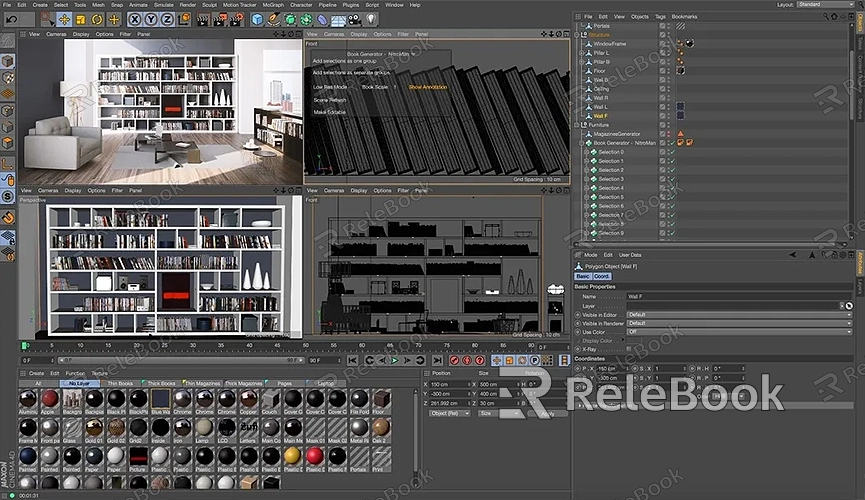How to Render Backface Culling in Blender
In 3D modeling and rendering, backface culling is a highly useful technique. It helps optimize the rendering process, improve efficiency, and reduce unnecessary resource consumption. Especially when creating complex models in Blender, the backface culling feature can significantly speed up rendering. This article will guide you on how to implement backface culling in Blender and help you better utilize this technique to enhance your workflow.
What is Backface Culling?
Backface culling refers to the process of removing invisible backfaces (i.e., faces facing away from the camera) during rendering. This technique significantly reduces the load on the graphics processor (GPU) during rendering, particularly in large-scale scenes, thereby improving rendering efficiency and reducing computation time.

When creating complex 3D models in Blender, many faces may be oriented away from the camera, and by default, these faces still participate in rendering, wasting resources. By enabling backface culling, Blender can avoid rendering these faces, optimizing the overall rendering process.
Enabling Backface Culling in Blender
The process of enabling backface culling is quite simple. You can follow these steps:
1. Access Render Settings
Open Blender and select the model for which you want to enable backface culling. In the right-hand panel, locate the "Properties" window and click on the "Render Properties" tab (represented by a camera icon). Here, you can adjust various rendering-related settings, including enabling backface culling.
2. Select Material Properties
In the "Properties" window, find the material settings option (indicated by a sphere icon) and select the material you want to apply backface culling to. Under the material settings, you will find the "Settings" tab. Here, you can adjust various options related to rendering.
3. Enable Backface Culling
In the material settings under the "Settings" tab, you will see an option called "Backface Culling." By default, this option is turned off. Simply check this option, and Blender will automatically ignore the faces that are facing away from the camera, optimizing the rendering process.

Note that after enabling backface culling, the backfaces of the model may become invisible in the view, but this does not affect the overall structure of the model. Instead, it helps you see more clearly which faces are actually visible and which can be disregarded.
Optimizing Rendering Performance
After enabling backface culling, you will notice a significant improvement in rendering performance. Especially in large scenes or complex models, backface culling can effectively reduce resource consumption, thereby shortening rendering times. Additionally, it can enhance the smoothness of animation rendering and reduce stuttering.
To further optimize rendering performance, you can combine backface culling with other techniques, such as reducing polygon count, optimizing texture map sizes, and using faster rendering engines like Eevee. These measures can maximize rendering efficiency while maintaining image quality.
Applications of Backface Culling
Backface culling has broad applications in various scenarios, especially in the following types of projects:
- Game Development: In games, typically only the front faces of characters or objects are rendered. The backfaces, being invisible, can be culled to improve game performance.
- Virtual Reality (VR) and Augmented Reality (AR): In these immersive experiences, scenes are often very complex. Enabling backface culling can significantly reduce rendering burdens.
- Architectural Visualization: In architectural rendering, some invisible parts of a model can be optimized through backface culling to reduce rendering time.
Enhancing Model Detail and Rendering Quality
While backface culling improves rendering efficiency, you may still need to maintain high-quality textures and details in some cases. Therefore, using high-quality 3D textures and model resources is essential.
If you need high-quality 3D textures and HDRIs for creating models and virtual scenes, you can download them for free from [Relebook](https://textures.relebook.com/). For beautiful 3D models, visit [Relebook](https://3dmodels.relebook.com/) where a wide range of high-quality resources is available to help you complete your designs with excellent visual effects.
Enabling backface culling in Blender is a simple yet effective optimization technique. By using this feature, you can reduce resource wastage from invisible faces, improve rendering efficiency, and achieve significant performance benefits, especially in handling complex scenes. Additionally, leveraging high-quality 3D resources ensures that you maintain model detail and image quality while enhancing rendering performance. Backface culling is an essential tool for optimizing the rendering process and assisting in various 3D design and animation projects.

